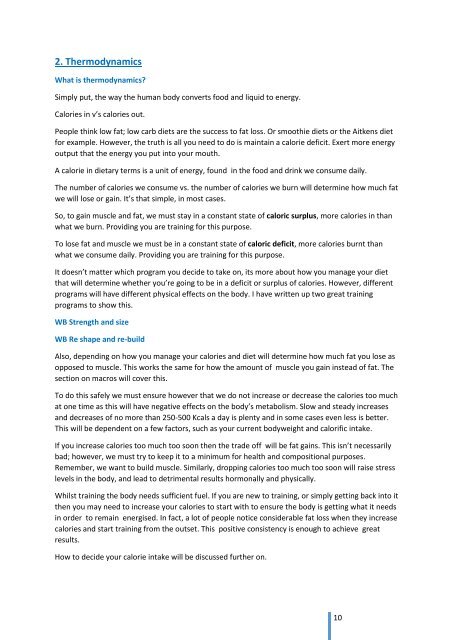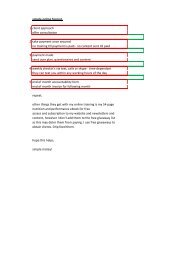Create successful ePaper yourself
Turn your PDF publications into a flip-book with our unique Google optimized e-Paper software.
2. Thermodynamics<br />
What is thermodynamics?<br />
Simply put, the way the human body converts food <strong>and</strong> liquid to energy.<br />
Calories in v’s calories out.<br />
People think low fat; low carb diets are the success to fat loss. Or smoothie diets or the Aitkens diet<br />
for example. However, the truth is all you need to do is maintain a calorie deficit. Exert more energy<br />
output that the energy you put into your mouth.<br />
A calorie in dietary terms is a unit of energy, found in the food <strong>and</strong> drink we consume daily.<br />
The number of calories we consume vs. the number of calories we burn will determine how much fat<br />
we will lose or gain. It’s that simple, in most cases.<br />
So, to gain muscle <strong>and</strong> fat, we must stay in a constant state of caloric surplus, more calories in than<br />
what we burn. Providing you are training for this purpose.<br />
To lose fat <strong>and</strong> muscle we must be in a constant state of caloric deficit, more calories burnt than<br />
what we consume daily. Providing you are training for this purpose.<br />
It doesn’t matter which program you decide to take on, its more about how you manage your diet<br />
that will determine whether you’re going to be in a deficit or surplus of calories. However, different<br />
programs will have different physical effects on the body. I have written up two great training<br />
programs to show this.<br />
WB Strength <strong>and</strong> size<br />
WB Re shape <strong>and</strong> re-build<br />
Also, depending on how you manage your calories <strong>and</strong> diet will determine how much fat you lose as<br />
opposed to muscle. This works the same for how the amount of muscle you gain instead of fat. The<br />
section on macros will cover this.<br />
To do this safely we must ensure however that we do not increase or decrease the calories too much<br />
at one time as this will have negative effects on the body’s metabolism. Slow <strong>and</strong> steady increases<br />
<strong>and</strong> decreases of no more than 250-500 Kcals a day is plenty <strong>and</strong> in some cases even less is better.<br />
This will be dependent on a few factors, such as your current bodyweight <strong>and</strong> calorific intake.<br />
If you increase calories too much too soon then the trade off will be fat gains. This isn’t necessarily<br />
bad; however, we must try to keep it to a minimum for health <strong>and</strong> compositional purposes.<br />
Remember, we want to build muscle. Similarly, dropping calories too much too soon will raise stress<br />
levels in the body, <strong>and</strong> lead to detrimental results hormonally <strong>and</strong> physically.<br />
Whilst training the body needs sufficient fuel. If you are new to training, or simply getting back into it<br />
then you may need to increase your calories to start with to ensure the body is getting what it needs<br />
in order to remain energised. In fact, a lot of people notice considerable fat loss when they increase<br />
calories <strong>and</strong> start training from the outset. This positive consistency is enough to achieve great<br />
results.<br />
How to decide your calorie intake will be discussed further on.<br />
10




